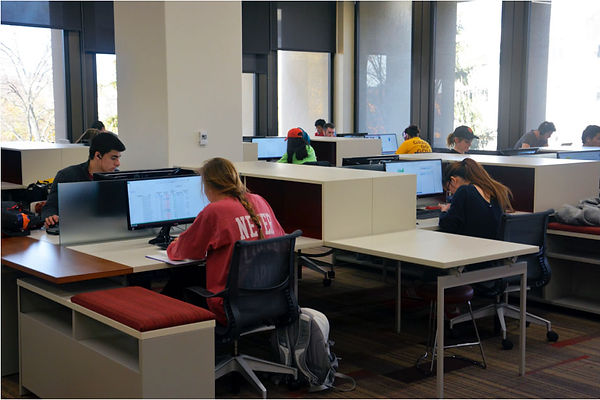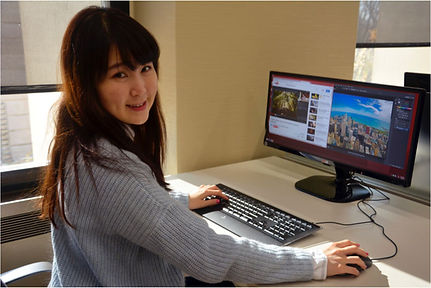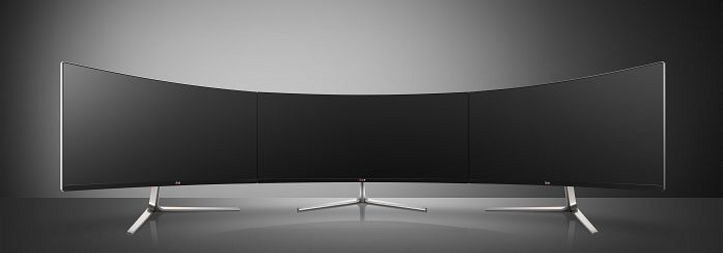
Multimedia/UX Designer

__________________________________________________________________
The world of a nimble and versatile practitioner.
Will the ultra-wide monitor be
ultra-helpful?
Needfinding Report for the Wells Library Scholars’ Commons of Indiana University
Overview
-
End Date: 11/2014
-
Duration: 2 weeks
-
Independent project
My Role
-
UX Designer
-
UX Researcher
Tools
-
Interview
-
Photoshop
-
Usability testing
-
User enactment
-
Scenario analysis
Background

Summer construction projects in Wells Library, Indiana University has already come to a close, and they have entirely transformed the first floor of the Library. With comfortable and convenient, the new computer stations in both the West Tower and the East Tower are providing the latest digital technology. One of the biggest renovations is that all standard-
aspect-ratio computers monitors have been replaced by the state-of-the-art ultra-wide monitors.
Practical Goal
This report is going to assess if the brand-new monitors can be fully exploited, and whether this improvement efficiently meets user needs or might generate some new frustrations. Hopefully the user needs gathered in the report as helpful feedback could assist the management team of IU Library to make more useful decisions in the future.
Research Methods

I'm another title

A hybrid method has been adopted based on qualitative research methodology that combines both observations and interviews:
(1). Direct observation:
Participants were all in the Well Library -- their natural environment. The study simply observed and recorded their real interactions and behaviors while they were operating computers with the ultra-wide monitor. In order to realistically collect data, researcher as an outsider, was only taking pictures and necessary notes without interrupting, talking to the participants or any other ways of participating.
(2). In-depth interviews:
Each participant was interviewed by the researcher in-depth and one-on-one. Rather than a specific set of questions that has to be asked in a particular order, the interviewer just had a general plan of inquiry which flows more like a casual conversation about changes in the library where the interviewee guides the direction of the interview. One key point for this in-depth interview is to encourage interviewees responding and reflecting as much as possible about the monitors. Compared with the objective observation, this study also requires some subjective feedback from the participants themselves.
Therefore this combination of both observations and interviews allows the report to draw more accurate conclusions.
Population and Sample


Since the library computer stations with ultra-wide monitors are available to all students and faculty in Indiana University, the population whom the researcher gather data from should be the entire enrolled students and employees of IU. To stratify the population into specific groups, the method of non-probability sampling was adopted.
Three participants were from different grades and different majors in IU:
Thomas E Jester, sophomore (Informatics);
Tessa Donolli, senior (Accounting)
Yan Li, second-year graduate (Journalism)
who represents an everyday user, an extreme user and an expert respectively.
User Needs

When users are multitasking on one computer, a standard monitor cannot provide enough space to display every open window without many of them overlapping or obscuring one another. With this in mind, ultra-wide monitors, as a panacea to this problem, were introduced to meet college users’ needs. This new monitor is best suited for text and coding work, where its pivoting feature will be welcome. Nevertheless it will not be a good choice for work with applications such critical photo and video editing through observations and interviews. So there are the 5 most insightful user needs to enhance the user experience and product itself.
(1). When Yan Li was editing picture in Photoshop, sometimes she needs a vertical monitor rather than an ultra-wide viewing which was a little bit distracting. Therefore it will be great if the ultra-wide monitor could be designed to manually rotate from the horizontal to the vertical viewing.
(2). Ultra-wide monitors are perfect when dealing with multitasks, but not everyone needs to operate multitasks at any time. When person are doing single task on computer, the standard monitor will be more visually helpful which provides the user a faster way to search content on a narrower screen. So some computers with standard monitors should also remain in the first floor of the library.
(3). Sometimes, when Thomas was using the library computer, he also would like to access his own laptop at the same time. Unfortunately, there is no any power source near the ultra-wide monitor. He has to upload those documents and files on his laptop to the Google drive, and then download them when logging in the library computer. It is really a frustrating process.
(4). Tessa Donolli who is less sensitive towards the technology stuff, felt hard to get used to the ultra-wide screen at first few times. There must be some other users like Tessa who needs a quick but necessary guide offered by librarians or other volunteers. Also it will also guide users to fully exploit the advantages of the ultra-wide monitor.
(5). The total number of available computers in the library has decreased a lot, since every new computer station with ultra-wide monitor occupies as twice space as the previous station. During the weekdays, finding an available seat of computer station is going to take 10 minutes. Sometimes students will have to stand aside until other users finish their work first.
Appendix
Interview: Yan Li
Iasked: “Compared to standard computer monitor, how do you, in general, think about this ultra wide monitor?”
Yan answered: “It was not very easy to get used to at first time, because of the difference in the monitor ratio.”
I asked: “Is it helpful when you are doing multi tasks on computer? Is it distracting when you are merely doing one task?”
Yan answered: “When using Microsoft Office software, it would be convenient. But sometimes when I are editing horizontal pictures in Photoshop, it is indeed helpful; however, when it comes to the vertical pictures or reading long article, it is not that helpful (but not very distracting).”
I asked: “Do you think it is necessary for the library to upgrade the monitor to the ultra wide?”
Yan answered: “Yes, it is necessary, but not for all the computers in the library. Even some computers need to be replaced of vertical monitors rather than ultra wide monitors.”
I asked: “Why did you use library’s computer, rather than your own PC/MAC?”
Yan answered: “It’s a better place to study in the library, because I am not productive at home. And sometimes, I need to print something in the library.”
Interview: Thomas E Jester
I asked: “Compared to standard computer monitor, how do you, in general, think about this ultra wide monitor?”
Thomas answered: “I think they flopped with movie lovers but ended up being a surprise hit with gamers. They are so large that games need to shift the HUD away from the sides because it's too far to comfortably see, but that's a good thing.”
I asked: “Is there any downside of this monitor?”
Thomas answered: “It’s like ultrawide with no bezels perfection. Only downside is that a few programs don’t full-screen on the monitor.”
I asked: “Do you think it is necessary for the library to upgrade the monitor to the ultra wide?”
Thomas answered: “Yes, it is! The ultrawide will be the future.”
I asked: “How much would like to pay for this monitor?”
Thomas answered: “Not even a penny. It is cool, but not enough to invest any money on that.”
Observation (Tessa Donolli):
Tessa Donolli is a senior with a major in Accounting. She described herself as a loyal visitor to the Wells Library, because half of her college time has been in this place. It was surprising to see that she still felt a little uncomfortable using the ultra-wide monitor, since it was her 20 or 30 times to use the computer station after the renovation construction.
During the 20 minutes observation, she was busy with her finance assignment that required her to code statistics in Excel. Unfortunately, she only multitasked one time when she opened the Chrome to search something on Google: she dragged the Excel window to the left side of the monitor while opened the new browser window in the right blank side. When she was solely operating Excel, she put the software interface in the middle of the monitor which only accounted for 1/3 of the total monitor viewing. The efficiency improved by the new monitor was not very significant in her case, yet it did not obviously reduce her productivity either.
